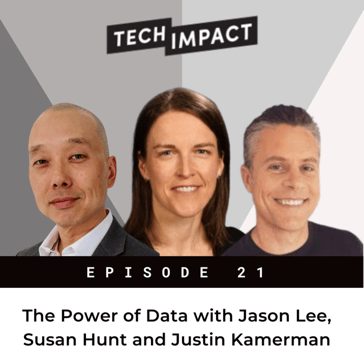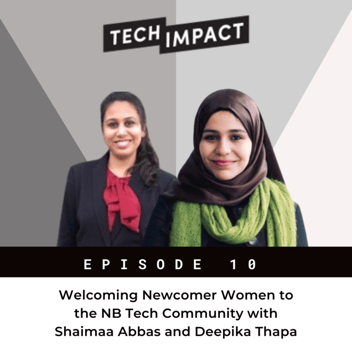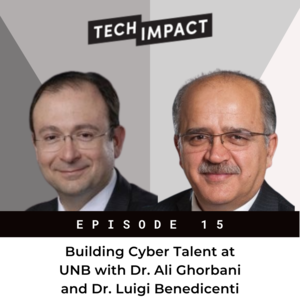EPISODE # 21 The Power of Data with Jason Lee, Susan Hunt and Justin Kamerman
TechImpact
THE POWER OF DATA

There’s more data than ever, and this week TechTalks delves into its scope, power and opportunities.
This episode continues our experimentation with taking the podcast outside the studio and into the community through webinars and other events. This show is adapted from a panel that I moderated on March 12 as part of the 2021 Virtual Data Challenge at UNB. The virtual event drew 38 teams from eight countries and five Canadian provinces who used data to tell stories and provide recommendations.
On this episode, I talks to three panellists working on transformational data products and projects about their career paths and perspectives on how data can advance ideas, support better, quicker decisions and build better products. Their range of backgrounds and experiences show that there are many fascinating paths to a data-driven career.

I’ve known Justin for about 15 years and we worked together at T4G for a short while. In his more than 20-year career in data architecture and data science, Justin’s seen the evolution of data’s relationship to product, powered by new tools and ever-cheaper computing power.
“Ten years ago, your product was largely driven by what was possible technologically,” he says. “Now, you're taking data and turning it into something else. There are two parallel streams: you have to build out the tech, but you also have to make sure that the data supports your hypothesis, which gives you a product.”
Justin’s path to data came through software, working with applications that evolved, over time, from simple functions to those that use data to make decisions.
“I feel like my software skills really dovetailed well into the more quantitative side of things,” says Justin, who upskilled his mechanical engineering background with graduate degrees in computer science and mathematics from UNB.
“Because all the tools used in the industry have come from the software side, it's a great complement to put those skills together.”
Today, he leads Instnt's product and engineering groups, where he’s responsible for the definition and delivery of the product and platform roadmap.
The New York-based SaaS company works in fraud risk detection and identity verification, using nontraditional data to help groups such as immigrants and millennials access credit while indemnifying banks’ risk. It’s a turnkey software service.
“You just drop some code on your webpage, and that routes it through our system,” Justin says. “It's a lot of engineering because it’s all real-time.”
Justin sees a shift in data from it being strictly the realm of data scientists who know the tech and tool to more domain knowledge coming to the fore.
“Sure, we have this massive IoT stack that can handle a million streaming events per second; that’s wonderful,” Justin says. “But if the data doesn't support you being able to use that to make quality decisions, then it's just going to sit there. It’s not going to be valuable.”
Susan Hunt, Chief Technology Officer, The Oceans Supercluster

Susan Hunt’s work has always been out to sea.
“I've done a bunch of different gigs, all primarily in the ocean space around innovation or product development or the management of the same,” she says.
A naval architect by training, she cut her teeth as a designer at Brunswick, the world’s largest boat designer and manufacturer, using data and mathematics to create blueprints for massive vessels.
“It’s one instance of how data gets visualized to create a product,” she says.
Susan also used data to test and refine the final product, spending thousands of hours on the water troubleshooting boat parts and systems.
“You get huge amounts of data coming in from the various types of equipment and sensors to help understand how a product is working,” she says. “So data is also really important to product development and commercialization.”
Susan, who has a graduate degree in information systems, has also seen data integrated across departments and databases for very high-level decision-making that transcends a single project or product.
“With that much data, you’re taking it up a step, you’re getting into a systems-level understanding,” she says. “You're getting to the point that you're using it to make decisions on not just a product level but at a portfolio level. What are the types of products we want to build, how are we working as a company together, how does our team need to be restructured to be more efficient?”
Her role as Canada’s Ocean Supercluster Chief Technology Officer builds on her subsequent experience in Atlantic Canada’s tech and research sectors. The organization is a collection of hundreds of companies and public sector organizations that collaborate on projects to improve Canada's competitiveness and productivity in the ocean space. To work together, they had to find common ground and challenges.
“The number one common denominator across different ocean sectors was lack of high-quality, real-time data,” Susan says. “It was the glue that actually bound companies and organizations from different sectors together around such a game-changing movement in Canada's ocean space.”
Jason Lee, Partner, MNP

Jason’s applied data group at MNP has a mantra: “Make better decisions and improve operations using data.”
That sounds simple enough, but it plays out in a wide range of ways, from advanced predictive analytics, artificial intelligence, machine learning, modelling, visualizations, and even data strategy and governance.
Often, they work in partnership with large tech companies to find solutions for customers, including Microsoft, with whom they’re a Gold Certified Data Partner.
“Partnering with someone like Microsoft is really an extension of your sales arm,” Jason says.
As one of the largest full-service business advisory firms in Canada, MNP’s projects span a dizzying range of sectors and take many forms. It means working with NHL and Olympic figure skaters to build an app powered by AI and data for grassroots talent development in Canada and beyond. Or taking a cue from Toyota on more efficient manufacturing.
“It’s starting to use all the sensor data from the assembly floor to swap out machinery and equipment at the right time, so that you wouldn't have this downtime on some of these machines”
More recently, he worked on the Digital Supercluster COVID-19 Program, which leverages data and predictive modelling to help businesses, emergency responders and policy leaders to make data-driven decisions.
And Jason says he increasingly sees how data comes into play in non-traditional departments, such as marketing.
“I've never really thought of marketing as a hard science,” Jason says. But that team uses tools such as Google Analytics for search engine optimization, and A/B testing for campaigns. It’s a great example of using data to solve real business problems, instead of what he calls “science fair projects,” where the data scientists present exciting numbers or models, but there’s no plan for implementation.
“How do I take this and actually apply it, and commercialize it, and monetize it, right?” Jason says. “Because that's what companies are going to be really interested in.”
======
Hear Cathy’s complete discussion with Justin, Susan and Jason by watching the panel discussion or listening to the podcast.
DON’T MISS AN EPISODE.
Do you subscribe to the Tech Talks With Cathy Simpson podcast? If not, please do. Every week, my guests and I will be covering lots of different topics around innovation, technology and the future. Click here to listen and subscribe in iTunes. You'll find us on Spotify, Apple Podcasts, Google Podcasts, PodLink and everywhere else you enjoy podcasts.
And sign up for our newsletter to never miss an update.
Visit Techimpact's website here
.png?width=600&height=187&name=Untitled%20design%20(2).png)


